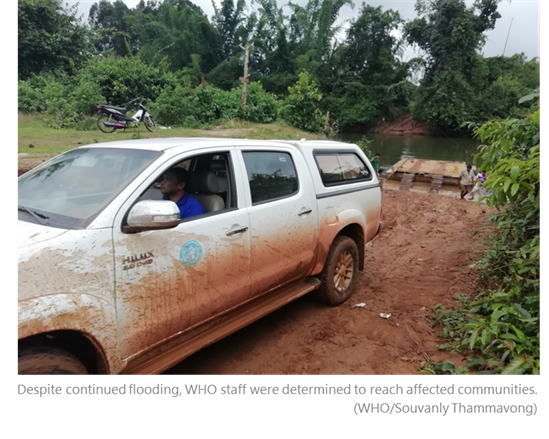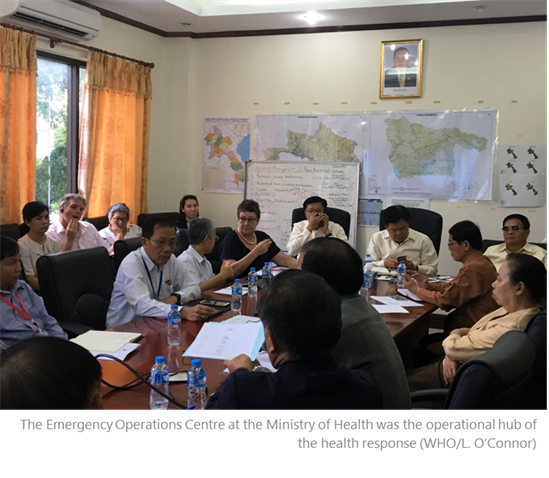During the evening of 23 July 2018, torrential rain overwhelmed a dam in Attapeu province in the far south of Lao People’s Democratic Republic. The consequences were catastrophic. A tsunami-like wave inundated villages downstream, wiping out houses, crops and roads, injuring people and claiming lives.
From the very first hours and days following the disaster, WHO worked hand-in-hand with the Ministry of Health and partners to respond. Continued flooding cut off roads and left some areas accessible only by helicopter, yet WHO staff reached Attapeu within 72 hours. The Organization focused on supporting local health authorities to coordinate emergency health teams and partners, prevent disease outbreaks, ensure access to water, sanitation and hygiene (WASH), and provide mental health services. WHO-trained health workers delivered psychological first aid to more than 600 people in just three weeks. The Organization also delivered equipment and supplies including stethoscopes, masks, blood pressure monitors, water purification tablets and chemicals for the removal of disease-carrying mosquitoes.
“We have a long history of working together – that’s why I called on my colleagues at WHO to help during this time of crisis,” said Lao Minister of Health, Bounkong Sihavong. “They were there alongside us every day in the Emergency Operations Centre and out in the affected district. Their support was invaluable.”

However, WHO merely played a back-up role in the response, supporting the efforts of the Ministry of Health, provincial health authorities and local health workers. Years of investment in the national health system meant that it could be rapidly repurposed to meet emergency health needs. The system’s in-built flexibility allowed health workers from the district level to be deployed to the evacuation centres, for example. District-level health workers were deployed to the inaccessible areas while health workers from the capital covered bases at the Sanamxay District Hospital, temporary shelters and camps. This meant that local health workers with a greater understanding of the local culture and local dialect were largely the ones providing care to flood-affected families.
" We have a long history of working together – that’s why I called on my colleagues at WHO to help during this time of crisis."
Bounkong Sihavong, Minister of Health
Prior investments in emergency preparedness also paid off. Following the framework for action laid out in the Asia Pacific Strategy for Emerging Diseases and Public Health Emergencies (APSED III), Lao PDR had trained epidemiologists and built disease surveillance systems which were used to prevent, detect and control disease outbreaks in the wake of the floods. The Public Health Emergency Operations Centre – established in accordance with another key APSED recommendation – functioned as an operational hub, coordinating the joints efforts of the Ministry of Health, WHO, UNICEF, WFP, UNFPA, IOM and other partners.

More than four months later, flood-affected families are beginning to rebuild their lives. But the impact of this disaster will be felt for months and perhaps years to come. At the end of November, around 4000 people were still living in temporary shelters waiting for their houses to be rebuilt in two or three months. Living in shared spaces may increase the risk of outbreaks of communicable diseases.
“The peak of the crisis may have passed but we will not forget these families,” said WHO Representative to Lao PDR, Mark Jacobs. “We’re in it for the long haul. We will continue to work alongside the Ministry of Health, in particular to support disease surveillance, vaccination, mosquito control and water quality testing to protect people from disease outbreaks.”
WHO’s initial response to flooding in Lao PDR was made possible thanks to an injection of US$ 50 000 from the WHO Contingency Fund for Emergencies (CFE). WHO wishes to thank contributors to the CFE including: Australia, Canada, China, Denmark, Estonia, France, Germany, India, Japan, Kuwait, Luxembourg, Malta, Netherlands, Norway, Republic of Korea, Sweden and the United Kingdom.
